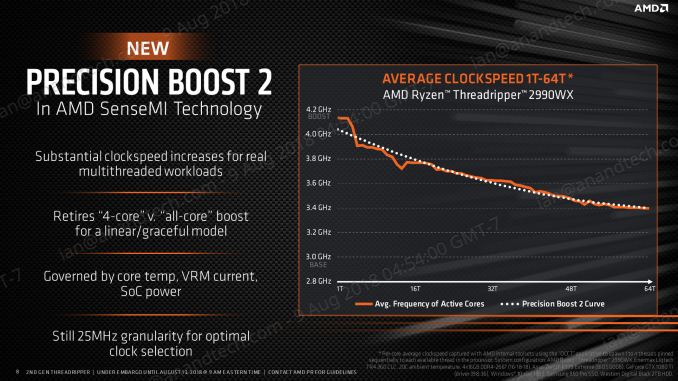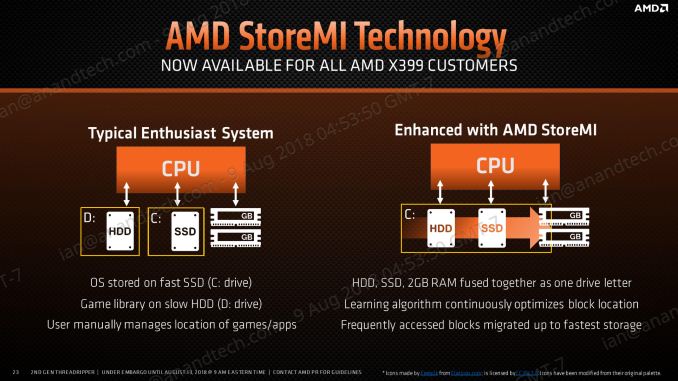The AMD Threadripper 2990WX 32-Core and 2950X 16-Core Review
by Dr. Ian Cutress on August 13, 2018 9:00 AM ESTPrecision Boost 2
Exact per-core turbo timings for the new processors will be determined by AMD’s voltage-frequency scaling functionality through Precision Boost 2. This feature, which we covered extensively in our Ryzen 7 2700X review, relies on available power and current to determine frequency, rather than a discrete look-up-table for voltage and frequency based on loading. Depending on the system default capabilities, the frequency and voltage will dynamically shift in order to use more of the power budget available at any point in the processor loading.
The idea is that the processor can use more of the power budget available to it than a fixed look up table that has to be consistent between all SKUs that are stamped with that number.
Precision Boost 2 also works in conjunction with XFR2 (eXtreme Frequency Range) which reacts to additional thermal headroom. If there is additional thermal budget, driven by a top-line cooler, then the processor is enabled to use more power up to the thermal limit and get additional frequency. AMD claims that a good cooler in a low ambient situation can compute >10% better in selected tests as a result of XFR2.
Ultimately this makes testing Threadripper 2 somewhat difficult. With a turbo table, performance is fixed between the different performance characteristics of each bit of silicon, making power the only differentiator. With PB2 and XF2, no two processors will perform the same. AMD has also hit a bit of a snag with these features, choosing to launch Threadripper 2 during the middle of a heatwave in Europe. Europe is famed for its lack of air conditioning everywhere, and when the ambient temperature is going above 30ºC, this will limit additional performance gains. It means that a review from a Nordic publication might see better results than one from the tropics, quite substantially.
Luckily for us we tested most of our benchmarks while in an air conditioned hotel thanks to Intel’s Data-Centric Innovation Summit which was the week before launch.
Precision Boost Overdrive
The new processors also support a feature called Precision Boost Overdrive, which looks at three key areas for power, thermal design current, and electrical design current. If any of these three areas has additional headroom, then the system will attempt to raise both the frequency and the voltage for increased performance. PBO is a mix of ‘standard’ overclocking, giving an all core boost, but gives a single core frequency uplift along with the support to still keep Precision Boost trying to raise frequency in middle-sized workloads, which is typically lost with a standard overclock. PBO also allows for idle power saving with a standard performance. PBO is enabled through Ryzen Master.
The three key areas are defined by AMD as follows:
- Package (CPU) Power, or PPT: Allowed socket power consumption permitted across the voltage rails supplying the socket
- Thermal Design Current, or TDC: The maximum current that can be delivered by the motherboard voltage regulator after warming to a steady-state temperature
- Electrical Design Current, or EDC: The maximum current that can be delivered by the motherboard voltage regulator in a peak/spike condition
By extending these limits, PBO gives rise for PB2 to have more headroom, letting PB2 push the system harder and further. PBO is quoted by AMD as supplying up to +16% performance beyond the standard.
AMD also clarifies that PBO is pushing the processor beyond the rated specifications and is an overclock: and thus any damage incurred will not be protected by warranty
StoreMI
Also available with the new Ryzen Threadripper 2 processors is StoreMI, AMD’s solution to caching by offering configurable tiered storage for users that want to mix DRAM, SSD, and HDD storage into a single unified platform. The software implementation dynamically adjusts data between up to 2GB of DRAM, up to 256 GB of SSD (NVMe or SATA), and a spinning hard drive to afford the best reading and writing experience when there isn’t enough fast storage.
AMD initially offered this software as a $20 add-on to the Ryzen APU platform, then it became free (up to a 256GB SSD) for the Ryzen 2000-series processors. That offer now extends to Threadripper. AMD’s best case scenario is citing a 90% improvement in loading times.













171 Comments
View All Comments
MattZN - Monday, August 20, 2018 - link
If its idling at 80-85W that implies you are running the memory fabric at 2800 or 3000MHz or higher. Try running the fabric at 2666MHz.Also keep in mind that a 2990WX running all 64 threads with a memory-heavy workload is almost guaranteed to be capped out by available memory bandwidth, so there's no point overclocking the CPU for those sorts of tests. In fact, you could try setting a lower PPT limit for the CPU core along with running the memory at 2666... you can probably chop 50-100W off the power consumption without changing the test results much (beyond the difference between 3000 and 2666).
It's a bit unclear what you are loading the threads with. A computation-intensive workload will not load down the fabric much, meaning power will shift to the CPU cores and away from the fabric. A memory-intensive workload, on the otherhand, will stall-out the CPU cores (due to hitting the memory bandwidth cap that 4 memory channels gives you), and yet run the fabric at full speed. This is probably why you are seeing the results you are seeing. The CPU cores are likely hitting so many stalls they might as well be running at 2.8GHz instead of 3.4GHz, so they won't be using nearly as much power as you might expect.
-Matt
XEDX - Monday, August 20, 2018 - link
What happened to the Chromium compile rate for the 7980XE? On it's own review posted on Sep 25th 2017, it achieved 36.35 compiles per day, but in this review it dropped all the way down to 21.1.jcc5169 - Saturday, August 25, 2018 - link
Intel Will Struggle For Years And AMD Will Reap The Benefits-- SegmentNext https://segmentnext.com/SWAPNALI - Tuesday, August 28, 2018 - link
nice place here thanks alot for this information please do more post here<a href="http://clash-of-royale.com/">play clash of royale</a>
Relic74 - Wednesday, August 29, 2018 - link
Regardless of the outcome, I went ahead and bought the 32 Core version. As I run SmartOS, an OS designed to run and manage Virtual Machines, I decided to go this route over the Epyc 24. My setup includes the new MSI MEG X399, 32 Core TR, 128GB DDR4 RAM, 3x Vega Frontier (used, $1000 for all three, no one wants them but I love them), 1 X Nvidia Titan Z (used for only $700, an amazing find from a pawn shop, did not know what he had, had it marked as an XP). Storage is 2 x 1TB Samsung 970 Pro in Raid 0 and 5x 8TB SATA in Raid 5 with 8GB of cache on card.The system is amazing and cost me much, much less than the iMac Pro I was about to buy. Now though, I can run any OS in VM, including OSX, with a designated GPU per VM and cores allocated to them. This setup is amazing, SmartOS is amazing, I have stopped running OS's with every application installed, Instead I create single purpose VM's and just install one or maybe two applications per. So for instance when I'm playing a game like DCS, a fantastic flight simulator, only has DCS and Steam installed on the VM. Allowing for the best performance possible, no, the lost of any performance by running things in VM are so minuscule that it's a none issue. DCS with the Titan V runs at over 200 FPS at 4K with everything turned to their max values. I have to actually cap games to my gaming monitors 144Hz refresh rate. Not only that but I can be playing the most demanding game their is, even in VR, while encoding a media file, while rendering something in Blender, while compiling an application, all tasks running under their own VM like a orchestra of perfection.
Seriously, I will never go back to a one OS at a time machine again, not when SmartOS exists and especially not when 32 Cores are available at your command. In fact, anyone who buys this CPU and just runs one single OS at a time is an idiot as you will never, ever harness it's full intention as no one single application really can at the moment or at least not to the point where it's worth doing it.
Most games dont need more than 4 cores, most design applications can't even use more than 2 cores, rendering applications use more of the GPU than CPU, in fact the only thing that really tasks my CPU is SmartOS that is controlling everything but even that doesn't need more than 6 cores to function perfectly, heck, I even had it at 12 cores but it didn't utilize it. So I have cores coming out of the yin-yang and more GPU's than I know what to do with. Aaaaahhhh poor, poor me.
This computer will be with me for at least 10 years without ever feeling that I need an upgrade, which is why I spent the money, get it right the first time and than leave it alone I say.
Oh and the memory management for SmartOS is incredible, I have set it up where if a VM needs more RAM, it will just grab it from another that isn't using it at the moment, it's all dynamic. Man, I am in love.
Anyway.....
Phaedra - Sunday, March 3, 2019 - link
Hi Relic74,I enjoyed reading your lengthy post on the technical marvel that is SmartOS and the 32 Core TR.
I am very much interested in the technical details of how you got SmartOS to work with AMD hardware. Which version of SmartOS, Windows, KVM (or BHYVE) with PCI passthrough etc?
I am in the process of preparing my own threadripper hyper computer and would love some advice regarding the KVM + PCI passthrough process.
You mention gaming in a VM so I assume that you used a Windows 10 guest via KVM with PCI passthrough?
The following says SmartOS doesn't support KVM on AMD hardware: https://wiki.smartos.org/display/DOC/SmartOS+Techn...
Did you build the special module with amd-kvm support:
https://github.com/jclulow/illumos-kvm/tree/pre-ep...
or
https://github.com/arekinath/smartos-live
I would appreciate any insight or links to documentation you could provide. I am familiar with Windows/Linux/BSD so you can let me have the nitty-gritty details, thanks
gbolcer - Wednesday, September 19, 2018 - link
Curious why virtualization disabled?Ozymankos - Sunday, January 27, 2019 - link
Your tests are typical for a single core machine which is laughableplease try to download a game with steam,play some music,watch tv on a tvtuner card,play a game on 6 monitors or 8 or 4 ,do some work like computing something in the background(not virus scanners,something intelligent like life on other planets)
then you shall see the truth
intel352 - Thursday, July 18, 2019 - link
Old article obviously, but wth, numerous benchmark graphics are excluding 2950x in the results. Pretty bad quality control.EthanWalker28 - Monday, February 24, 2020 - link
If you are looking for custom writing firm to help you out with your academic writing issues, then you have just found the right one. Now, you don’t have to worry about getting a failing mark simply because you have been accused of plagiarizing someone else’s work. Check this <a href="https://ewriters.pro/" rel="nofollow">ewriters.pro</a> Order essay online staying 100% safe and confidential.